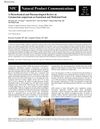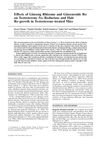Search
forLearn
2 / 2 resultslearn Dutasteride
Heavy duty finasteride that comes with higher risks, but scalp injections seem safe and are gaining popularity
Research
5 / 382 resultsresearch Antioxidant and 5α-Reductase Inhibitory Activity of Momordica Charantia Extract, and Development and Characterization of Microemulsion
Bitter melon extract may help prevent hair loss and can be used in cosmetic products.
research Synthesis and 5α-Reductase Inhibitory Activity of C21 Steroids Having 1,4-Diene or 4,6-Diene 20-Ones and 4-Azasteroid 20-Oximes
Three specific 4-azasteroid-2-oximes showed strong enzyme inhibition, but less than finasteride.

research A Phytochemical and Pharmacological Review on Cynomorium Songaricum as Functional and Medicinal Food
Cynomorium songaricum has many health benefits and could help with hair regrowth.

research 5α-Reductase Inhibition and Hair Growth Promotion of Some Thai Plants Traditionally Used for Hair Treatment
Some Thai plants, especially Carthamus tinctorius, could help prevent hair loss and promote hair growth without adverse effects.

research Effects of Ginseng Rhizome and Ginsenoside Ro on Testosterone 5α-Reductase and Hair Regrowth in Testosterone-Treated Mice
Ginseng, especially red ginseng, may help regrow hair and block a hair loss-related enzyme.
Community Join
5 / 1000+ resultscommunity DHT and 5AR respect post, it's importance within the brain
The conversation discusses whether to use finasteride for hair loss, considering its role in inhibiting DHT and 5AR, which can affect brain function and mood. Some users report anxiety and depression from finasteride, while others do not experience these side effects and emphasize the importance of DHT for brain and prostate health.
community Topical Finasteride Doesn't Directly Reduce 5ar Enzyme on Scalp
Topical Finasteride doesn't directly reduce 5ar enzyme on scalp and has the same mechanism as oral, needing to go through the liver. Users debate the accuracy of this information and discuss various studies and experiences.
community Finasteride does deplete important nuero-active steroids
Finasteride can reduce neuroactive steroids, causing side effects like depression, anxiety, and sexual dysfunction. Some users experience persistent symptoms after stopping finasteride, while others use alternative treatments like topical solutions.

community FCE 28260: A Forgotten 5α-Reductase Inhibitor
FCE 28260 (PNU 156765), an under-explored 5α-reductase inhibitor, showcases promising results in research by Giudici et al., outperforming well-known treatments like Finasteride in reducing the conversion of testosterone to DHT. Its superior efficacy, demonstrated through lower IC50 values in both natural and human recombinant enzyme studies, suggests it could offer more effective management of DHT-related conditions. Additionally, its lower molecular weight hints at better potential for topical application, potentially offering advantages in treating conditions such as androgenic alopecia. Despite its potential, it has not advanced in development, possibly due to financial limitations, leaving its therapeutic prospects and side effect profile largely unexplored.
community VDPHL-01 is Overrated and Ridiculous. This is just Oral Minoxidil.
VDPHL-01 is essentially a slow-release oral minoxidil, which is already known to work for hair growth. The formulation includes other ingredients like Medrogestone, Valproic acid, Setipiprant, and Cetirizine, but their effectiveness and necessity are questioned.